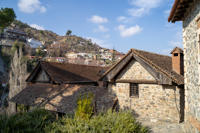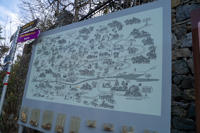Monastery of Saint John Lampadistes
Nestled in the scenic Troodos mountain range of central Cyprus lies the Monastery of Saint John Lampadistes. This beautiful complex is renowned for its stunning Byzantine paintings, which have been carefully preserved since the 11th century. Today, it is considered one of the most important monuments of the history of Byzantine painting, boasting brilliant examples of various trends of the Byzantine and post-Byzantine monumental art from the 11th to the 19th century.
The monastery is located in the valley of Marathasa, on the east bank of the river Setrachos, opposite the village of Kalopanagiotis. In 1985, it was added to the UNESCO World Heritage List along with nine other painted Byzantine churches of the Troodos range. While the exact founding date of the monastery is unknown, the katholicon (monastery church) dedicated to Saint Herakleidios is dated to the 11th century.
Over the years, the complex has undergone numerous constructions and renovations, resulting in a group of buildings that is a mix of different architectural periods. The main monastery church is a domed cross-in-square structure, with the chapel of Agios Ioannis Lampadistis added to the north of the first church in the 12th century, above the tomb of the Saint. This chapel collapsed and was almost entirely rebuilt in the 18th century. In the middle of the 15th century, a common narthex was built to the west of the two churches, while during the second half of the 15th century, a vaulted chapel was added to the north of that of Saint Ioannis. This chapel, known as the 'Latin chapel', was assumed to have been built for the Latins (Catholics) and is an example of the coexistence of the two rites under the same roof, reflecting the atmosphere of tolerance that prevailed in Cyprus after the Council of Ferrara-Florence (1439).
The wall-paintings of the monastery of Agios Ioannis Lampadistis reflect its architectural history. The apse of the southern church of Agios Herakleidios, as well as some other parts, preserve fragmentary scenes dated to the 11th and 12th century. The rest of the church was painted in the 13th and 14th century. These frescoes are an important group and include some rare representations, such as the depiction of the Holy Handkerchief on the north pier supporting the dome.
The decoration of the narthex belongs to a later date and is the work of an artist from Constantinople, who fled to Cyprus after the fall in 1453. These wall-paintings follow the trends of the Byzantine capital, but are not of such high quality. On the other hand, the frescoes of the 'Latin' chapel, dated to around 1500, belong to the 'Italo-byzantine' style, which combines Byzantine and Italian Renaissance elements. This chapel is the most complete set of this style in Cyprus.
The monastery of Agios Ioannis Lampadistis also boasts some important relics. The wooden templon screen, dated to the 13th -14th century, is the oldest wooden templon of Cyprus, with painted decoration imitating coats-of-arms. Additionally, the relic of Saint Ioannis Lambadistis is preserved in a precious reliquary. It is in a special niche and on the wall above it, many signatures of eponymous and anonymous pilgrims and travelers who had visited the monastery in the past can be seen.
Apart from the complex of the three churches, there are other monastic buildings, including cells, auxiliary rooms, and an oil press. One of the rooms is used today to house icons from the monastery as well as other churches of the village of Kalopanagiotis.
The Monastery of Saint John Lampadistes is not only an important religious site but also a fascinating historical and cultural monument. The architecture, frescoes, and other decorative elements provide insight into the development of Byzantine and post-Byzantine art in Cyprus.
Visitors can marvel at the intricate frescoes and admire the unique combination of Byzantine and Italian Renaissance styles in the 'Latin' chapel. The wooden templon screen with painted coats-of-arms is another fascinating example of the artistry of the time. Additionally, the reliquary containing the relic of Saint Ioannis Lampadistis is a precious and rare artifact that gives a glimpse into the monastery's past.
The monastery is located in a picturesque area in the Troodos Mountains, making it an ideal destination for nature lovers and history buffs alike. The surrounding area offers hiking trails, stunning views, and the opportunity to experience traditional Cypriot village life.
The Monastery of Saint John Lampadistes is a true gem of Cypriot history and culture. Its UNESCO World Heritage status is well deserved, and it continues to attract visitors from all over the world. Whether you are interested in art, history, or religion, a visit to this monastery is a must-see on any trip to Cyprus.
General Information
Ratings
Spectacular
1
Fantastic
0
Enjoyable
0
Average
0
Terrible
0
5.0


